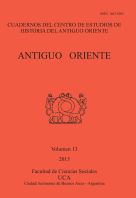Please use this identifier to cite or link to this item:
https://repositorio.uca.edu.ar/handle/123456789/6619| Título: | King Taita and his “Palistin” : philistine state or neo-hittite kingdom? El rey Taita y su “Palistin”: ¿estado filisteo o reino neo-hitita? |
Autor: | Emanuel, Jeffrey P. | Palabras clave: | ORIENTE ANTIGUO; EDAD DE BRONCE; EDAD DE HIERRO; TOPONIMIA; HISTORIA ANTIGUA; POBLACIONES ANTIGUAS; HITITAS; FILISTEOS | Fecha de publicación: | 2015 | Editorial: | Pontificia Universidad Católica Argentina. Facultad de Ciencias Sociales. Centro de Estudios de Historia del Antiguo Oriente | Cita: | Emanuel, J.P. King Taita and his “Palistin” : philistine state or neo-hittite kingdom? [en línea]. Antiguo Oriente. Cuadernos del Centro de Estudios de Historia del Antiguo Oriente. 2015, 13 Disponible en: https://repositorio.uca.edu.ar/handle/123456789/6619 | Resumen: | Abstract: The end of the Hittite Empire and the destruction and abandonment of Alalakh represents a cultural break between the Late Bronze and Early Iron Ages in the ‘Amuq Valley. In the Iron I, a population with clear ties to the greater Aegean world, perhaps related to the Philistines of southern Canaan, established an agro-pastoral settlement at Tell Ta‘yinat and the surrounding area. This occupation, marked by Field Phases 6–3 at Ta‘yinat, was both materially and chronologically ephemeral, and should be viewed as a cultural outlier sandwiched between the Hittite-controlled LBA and later Iron I. This intrusive population lived alongside the indigenous inhabitants of the ‘Amuq, bequeathing to the region a toponym—Palistin—that would far outlast their own relevance and archaeological visibility. By the First Building Period at Tell Ta‘yinat, which followed the Aegean-related phases, the site was home to a dynasty overseeing a typical Neo-Hittite state, with its toponym all that remained of the “Sea Peoples” presence that occupied it at the beginning of the Iron Age. Resumen: El final del imperio hitita y la destrucción y abandono de Alalak representan una ruptura cultural entre la Edad del Bronce Tardío y la Edad del Hierro Temprana en el valle del ‘Amuq. En la Edad del Hierro I, una población con nexos claros con el mundo del Egeo, quizás relacionada con los filisteos del sur de Canaán, estableció un asentamiento agro-pastoral en Tell Ta‘yinat y el área circundante. Esta ocupación, marcada por las fases 6–3 en Ta‘yinat, fue material y cronológicamente efímera, y debería ser vista como una fase cultural atípica ubicada entre la etapa de la Edad del Bronce Tardío controlada por los hititas y más tarde la Edad del Hierro I. Esta población intrusiva vivió junto a los habitantes nativos del ‘Amuq, y legó a la región un topónimo—Palistin—que sobrevivió más allá de la relevancia y visibilidad arqueológica de este grupo. En el primer período de construcción en Tell Ta‘yinat, que siguió a las fases relacionadas con el Egeo, el sitio albergó a una dinastía que dirigía un típico estado neo-hitita, y su topónimo fue lo único que quedó de la presencia de los”Pueblos del mar”’ que lo ocuparon a comienzos de la Edad del Hierro. |
Cobertura Espacial: | PALESTINA | URI: | https://repositorio.uca.edu.ar/handle/123456789/6619 | ISSN: | 1667-9202 | Disciplina: | HISTORIA | Derechos: | Acceso Abierto | Fuente: | Antiguo Oriente. Cuadernos del Centro de Estudios de Historia del Antiguo Oriente. 2015, 13 |
| Appears in Collections: | AO - 2015 vol. 13 |
Files in This Item:
| File | Description | Size | Format | |
|---|---|---|---|---|
| king-taita-palistin-emanuel.pdf | 231,27 kB | Adobe PDF |  View/Open |
Page view(s)
1,054
checked on Apr 30, 2024
Download(s)
337
checked on Apr 30, 2024
Google ScholarTM
Check
This item is licensed under a Creative Commons License

